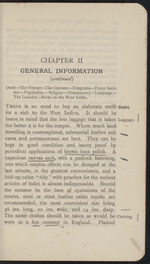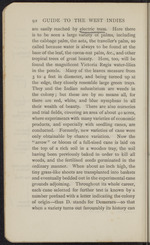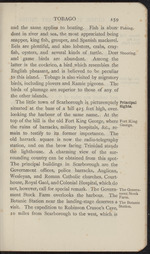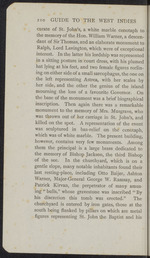| 1 |
 |
“...better it is for the temper. Where much land
travelling is contemplated, substantial leather suit ^
cases and portmanteaux are best. They can be
kept in good condition and insect proof by
periodical applications of brown boot polish. A
capacious canvas sack, with a padlock fastening,
into which surplus effects can be dumped at the
last minute, is the greatest convenience, and a
fold-up cabin “ tidy ” with pouches for the various
articles of toilet is almost indispensable. Should
the steamer be the base of operations of the
tourist, steel or stout leather cabin trunks are
recommended, the most convenient size being
36 ins. long, 20 ins. wide, and 14 ins. deep.------
The same clothes should be taken as would be Clothing. |
worn in a hot summer in England. Flannel...”
|
|
| 2 |
 |
“...92 GUIDE TO THE WEST INDIES
are easily reached by electric tram. Here there
is to be seen a large variety of palms, including
the cabbage palm, the aeta, the traveller’s palm, so
called because water is always to be found at the
base of the leaf, the cocoa-nut palm, &c., and other
tropical trees of great beauty. Here, too, will be
found the magnificent Victoria Regia water-lilies
in the ponds. Many of the leaves measure from
3 to 4 feet in diameter, and being turned up at
the edge, they closely resemble large green trays.
They and the Indian nelumbrium are weeds in
the colony; but these are by no means all, for
there are red, white, and blue nympheas in all
their wealth of beauty. There are also nurseries
and trial fields, covering an area of about 40 acres,
where experiments with many varieties of economic
products, and especially with seedling canes, are
conducted. Formerly, new varieties of cane were
only obtainable by chance variation. Now the
“ arrow ” or bloom of a full-sized cane...”
|
|
| 3 |
 |
“...Street is open from 7 a.m.
to 4 p.m. ; on Saturdays from 7 a.m. to noon;
and on Sundays and public holidays from 7 a.m.
to 8 p.m. The Savannah, known as Queen’s
Park, an extensive open space of nearly 130 acres,
is the centre of life in Trinidad, round which
is the fashionable residential quarter. It has few
trees except round the edge, but a clump of cabbage
palms popularly known as the Seven Sisters forms
a particularly noticeable feature. The Savannah
is covered with grass, on which golf, polo, base-
ball, football, and other games are played. It
is here also that the racecourse, with its stands,
is situated. This pleasure ground, round the
inside of which the electric trams run, is fringed
with the villas and mansions of the well-to-do,
and it is surrounded by an asphalt road which
presents an animated appearance in the cool of
the evening when the rank and fashion of
Trinidad take their airing. The fireflies after
dark are very numerous and strikingly beautiful.
Government House stands...”
|
|
| 4 |
 |
“...148 QUIDE TO THE WEST INDIES
at the instance of Sir Nevile Lubbock, who was
also responsible for the development of cane
farming, a system by which peasant proprietors
grow sugar canes and deliver them when ripe to
the factory. The principle of the central factory
system in which the future of the West Indian
sugar industry is believed to lie, is the grouping
together of a number of estates whose sugar
canes are ground at one central base, with the
result that a considerable saving of expense is
effected. The canes are brought to the factory
by locomotives over railways, of which there
are some sixty miles running through or in
communication with the estates which feed this
particular Usine.
Princes Princes Town (8 miles by rail, and 7 by road
Town. from San Fernando) is chiefly worthy of notice
on account of the mud volcanoes some little
distance away, which, it must be admitted, are,
however, rather disappointing. Prior to a visit
of Prince Albert Victor and Prince George of
Wales, during...”
|
|
| 5 |
 |
“...mackerel.
Eels are plentiful, and also lobsters, crabs, cray-
fish, oysters, and several kinds of turtle. Deer shooting,
and game birds are abundant. Among the
latter is the cockrico, a bird which resembles the
English pheasant, and is believed to be peculiar
to this island. Tobago is also visited by migratory
birds, including plovers and Ramie pigeons. The
birds of plumage are superior to those of any of
the other islands.
The little town of Scarborough is picturesquely Principal
situated at the base of a hill 42 5 feet high, over. SightB‘
looking the harbour of the same name. At the
top of the hill is the old Fort King George, where Fort King
the ruins of barracks, military hospitals, &c., re- eorge'
main to testify to its former importance. The
old barrack square is now the radio-telegraphy
station, and on the brow facing Trinidad stands
the lighthouse. A charming view of the sur-
rounding country can be obtained from this spot-
The principal buildings in Scarborough are the
Government offices...”
|
|
| 6 |
 |
“...evacuate the island, only visiting it for the purpose
of securing wood and water until some definite
decision was arrived at. In 1748 the island was
declared by the Treaty of Aix-la-Chapelle to be
neutral. St. Lucia capitulated to Admiral Rodney
and General Monckton in 1762, but it was restored
to France in the following year by the Treaty of
Paris. When war broke out with France in 1778,
Rodney impressed upon the Government the
necessity of taking St. Lucia which he regarded
as an ideal naval base, and a powerful body of
troops was landed at Grand Cul de Sac Bay.
Count d’Estaing, who opposed them with a strong
force, was beaten off, and until the end of the war
the island remained British, in spite of an attempt
to recapture it in 1781; and it was from Gros
Islet Bay, at the north-east of the island, that
Rodney sailed with his fleet and inflicted a deci-
sive defeat on Count de Grasse between Dominica
and Guadeloupe on the memorable 12th April
1782. St. Lucia was restored to the French...”
|
|
| 7 |
 |
“...200 GUIDE TO THE WEST INDIES
the base of the two conical mountains known as
The Pitons. the Pitons or the Peaks, which form prominent
landmarks on the leeward coast. The Gros Piton
is said to be 2619 feet high, the Petit Piton 2461
feet. The Gros Piton is comparatively easy to
ascend, but, until 1878, the smaller Piton was un-
conquered by man. In that year, however, a Mr.
Lompré succeeded in gaining its summit, and,
shortly after, it was ascended by Chief Justice
Carrington and a party. Local tradition relates
that four English sailors once tried to climb the
highest Piton. They were watched from below
through a telescope, and one after the other dis-
appeared. Half-way up one fell, a little higher
another dropped, and then a third. It was sup-
posed that they fell victims to the deadly Fer-de-
lance snake, which once infested St. Lucia.
nilond BetWeen St‘ Lucia and Martinique there stands
Rock. an isolated rock, which rises sheer out of the
water off the south coast of the latter island...”
|
|
| 8 |
 |
“...of the Hon. William Warner, a descen-
dant of Sir Thomas, and an elaborate monument to
Ralph, Lord Lavington, which were of exceptional
interest. In the latter his lordship was represented
in a sitting posture in court dress, with his plumed
hat lying at his feet, and two female figures reclin-
ing on either side of a small sarcophagus, the one on
the left representing Astrea, with her scales by
her side, and the other the genius of the island
mourning the loss of a favourite Governor. On
the base of the monument was a brief biographical
inscription. Then again there was a remarkable
monument to the memory of Mrs. Musgrave, who
was thrown out of her carriage in St. John’s, and
killed on the spot. A representation of the event
was sculptured in bas-relief on thë cenotaph,
which was of white marble. The present building,
however, contains very few monuments. Among
them the principal is a large brass dedicated to
the memory of Bishop Jackson, the third Bishop
of the see. In the churchyard...”
|
|
